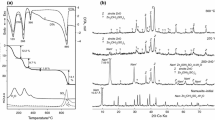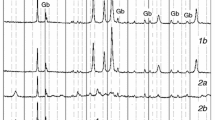Abstract
A new compound, NaZn4(OH)6(SO4)Br·6H2O named “Br-gordaite”, was obtained by mixing of ZnO with a solution of ZnSO4 and NaBr. The Br− ion occupies the Cl− ion tetrahedral position of the brucite-like layer of the gordaite structure without any other changes relating to the structure and chemical composition. The thermal decomposition of the new phase was studied by DSC–TG(DTG)–MS in regard to the thermal events and mass loss during volatile releasing, while phase composition and chemical composition of the initial and heating products were studied by XRD and SEM–EDAX, respectively. All processes are endothermic: (1) dehydration (20–185 °C), (2) dehydroxylation (185–320 °C), (3) evolving of bromine (400–600 °C) and (4) evolving of SO3 (770–1165 °C). One-stage releasing of bromine from the “Br-gordaite” was observed at 400–600 °C. Bromine-containing intermediate crystalline phases were not detected by XRD during the “Br-gordaite” decomposition. The presence of bromine in the solid residue at 340 °C was established by chemical analysis, while after 600 °C the bromine was no longer present. The final products of the thermal decomposition of “Br-gordaite” are ZnO and traces of Na2Zn(SO4)2. The thermal behavior and the obtained thermal decomposition products of the “Br-gordaite” were compared with other minerals with Zn octahedral–tetrahedral hydroxide layer.




Similar content being viewed by others
References
Bevins RE, Turgoose S, Williams PA. Namuwite, (Zn,Cu)4SO4(OH)6·4H2O, a new mineral from Wales. Mineral Mag. 1982;46:51–4.
Ohnishi M, Kusachi I, Kobayashi S. Osakaite, Zn4SO4(OH)6·5H2O, a new mineral species from the Hirao mine, Osaka, Japan. Can Mineral. 2007;45:1511–7.
Nasdala L, Witzke T, Ullrich B, Brett R. Gordaite [Zn4Na(OH)6(SO4)Cl·6H2O]: second occurrence in the Juan de Fuca Ridge, and new data. Am Mineral. 1988;83:1111–6.
Ts Stanimirova. Crystal chemical preconditions for the species diversity of minerals-hydroxy-salts. Geosciences. 2017;2017:35–6.
Groat LA. The crystal structure of namuwite, a mineral with Zn in tetrahedral and octahedral coordination, and its relationship to synthetic basic zinc sulfates. Am Mineral. 1996;81:238–43.
Adiwidjaja G, Frise K, Klaska K-H, Schlüter J. The crystal structure of gordaite NaZn4(SO4)(OH)6Cl·6H2O. Z Kristallogr. 1997;212:704–7.
Hawthorne FC, Schindler M. Topological enumeration of decorated [Cu2+ф2]N sheets in hydroxy-hydrated copper oxysalt minerals. Can Mineral. 2000;38:751–61.
Stanimirova T, Petrova N, Kirov G. Thermal decomposition of zinc hydroxyl-sulfate-hydrate minerals. J Therm Anal Calorim. 2016;125(1):85–96.
Volovitch P, Allely C, Ogle K. Understanding corrosion via corrosion product characterization: I. Case study of the role of Mg-alloying in Zn–Mg coating on steel. Corros Sci. 2009;51:1251–62.
Hongo T, Lemur TS, Satokawa S, Yamazaki A. Chromate adsorption and pH buffering capacity of zinc hydroxy salts. Appl Clay Sci. 2010;48:455–9.
Peng HE, Gao X-D, Wu L-B, Jiang Z-W, Wang C-L, Li X-M. Porous ZnO sheets transformed from zinc sulfate hydroxide hydrate and their photoluminescence performance. Acta Phys Chem Shin. 2013;29:874–80.
Moezzi A, Cortie MB, McDonagh AM. Zinc hydroxide sulfate and its transformation to crystalline zinc oxide. Dalton Trans. 2013;42:14432–7.
Liang W, Li W, Chen H, Liu H, Zhu L. Exploring electrodeposited flower-like Zn4(OH)6SO4·4H2O nanosheets as a precursor for porous ZnO nanosheets. Electrochim Acta. 2015;156:171–8.
Gorodylova N, Cousy S, Sulcova P, Svoboda L. Thermal transformation of layered zinc hydroxide chloride: a review. J Therm Anal Calorim. 2017;127:675–83.
Kozawa T, Onda A, Yanagisawa K, Kishi A, Masuda Y. Effect of water vapor on the thermal decomposition process of zinc hydroxide chloride and crystal growth of zinc oxide. J Solid State Chem. 2011;184:589–96.
Kołodziejczak-Radzimska A, Jesionowski T. Zinc oxide—from synthesis to application: a review. Materials. 2014;7:2833–81.
Arulraj J, Rajamathi JT, Prabhu KR, Rajamathi M. Anionic clays as hosts for anchored synthesis: interlayer bromination of maleate and fumarate ions in nickel-zinc layered hydroxy double salt. Solid State Sci. 2007;9:812–6.
Tahir R, Banert K, Solhy A, Sebti S. Zinc bromide supported on hydroxyapatite as a new and efficient solid catalyst for Michael addition of indoles to electron-deficient olefins. J Mol Catal A Chem. 2006;246:39–42.
Joshi G, Patil RD, Adimurthy S. Green bromine: in situ generated catalyst for the selective oxidation of alcohols using H2O2 as a benign oxidant. RSC Adv. 2012;2:2235–9.
Petkova V, Kostova B, Shopska M, Kadinov G, Baláž M, Baláž P. Behavior of high-energy-milling-activated eggshells during thermal treatment. J Therm Anal Calorim. 2017;127(1):615–23.
Lin Y, Zheng M, Ye C, Power I. Thermogravimetric analysis–mass spectrometry (TG–MS) of hydromagnesite from Dujiali Lake in Tibet, China. J Therm Anal Calorim. 2018;133:1429–37.
Varga J, Wohlfahrt S, Fischer M, Saraji-Bozorgzad M, Matuschek G, Denner T, Reller A, Zimmermann R. An evolved gas analysis method for the characterization of sulfur vapor. J Therm Anal Calorim. 2017;127:955–60.
Hribar B, Southall NT, Vlachy V, Dill KA. How ions affect the structure of water. J Am Chem Soc. 2002;124(41):12302–11.
Author information
Authors and Affiliations
Corresponding author
Additional information
Publisher's Note
Springer Nature remains neutral with regard to jurisdictional claims in published maps and institutional affiliations.
Rights and permissions
About this article
Cite this article
Delcheva, Z., Stanimirova, T., Petrova, N. et al. Thermal decomposition of bromine gordaite: NaZn4(OH)6(SO4)Br·6H2O. J Therm Anal Calorim 138, 2233–2240 (2019). https://doi.org/10.1007/s10973-019-08217-5
Received:
Accepted:
Published:
Issue Date:
DOI: https://doi.org/10.1007/s10973-019-08217-5




